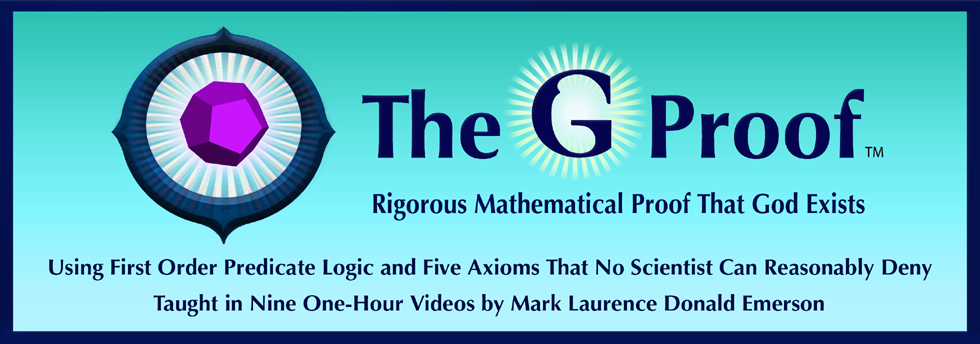Video 6: Undefined Terms, Definitions and First 3 Axioms
Short Synopsis of Video 6
This is the first of three Videos (Six, Seven and Eight) that present our proof that God exists. Presents and carefully explains our three undefined terms: phenomena (the nouns in our theory), the "is-a-part-of" predicate, and the "causes" predicate. Our first three definitions are presented: S ("is self caused"), C ("causes something"), and O ("is omnipotent" i.e. causes everything). The first three of our five axioms — A1, A2 and A3 — are presented and justified.

|
Long Synopsis of Video 6
Video Six is the first of three Videos (Six, Seven and Eight) that present our proof that God exists. Videos Six and Seven set the stage, and then Video Eight presents the proof.
Video Six begins with a quick review of Videos One through Five, and additional remarks about Version 1 and Version 2 of G Theory.
Presents our three undefined terms: phenomena (the nouns in our theory), the "is-a-part-of" predicate, and the "œcauses" predicate. Numerous examples are presented to explain these undefined terms. Phenomena are distinguished by single vs. collection, by time vs. beyond time, by place, including everywhere and nowhere, by degree of abstraction, by state vs. process, by type vs. instance. It is required that phenomena be themselves unambiguous, and that their relationships with other phenomena (via the two undefined predicates, "is-a-part-of" and "causes" also be unambiguous.
Explains that "is-a-part-of" means necessary part, based on the No Donut Holes Principle. The "causes" predicate is discussed at length, including that it means sufficient cause, that it forms the basis for answering "Why?" questions, and how it is generally related to time, but that we take a broader view that it need not be based on time (Why does time exist?).
Distinguishes a relative phenomenon (caused by a different phenomenon) from an absolute phenomenon (which is not). Two types of absolute phenomena are then distinguished (self-caused and uncaused). Several examples of possible absolute phenomena are discussed: identity, logical tautologies, energy (E=mc2) and "absolute truth." We remark that the distinction between absolute phenomena that are self-caused vs uncaused probably doesn't matter, that in these Nine Videos, we take the view that they are self-caused, but that we drop that restriction in Version 2 of G Theory.
Presents our first three definitions: S ("is self caused"), C ("causes something"), and O ("is omnipotent" i.e. causes everything).
The first three of our five axioms are presented and justified. Axiom A1, the Sufficient Reason Axiom, states that every phenomenon has a cause — to deny Axiom A1 is to undermine the process of scientific scrutiny. Axiom A2, the Transitivity Axiom, states that causation can happen in a chain, as exemplified by falling dominoes: if a first phenomenon causes a second, which in turn causes a third, then the first causes the third. Axiom A3, the Non-Circularity Axiom, prohibits two-way causation loops, and prevents the logical fallacy of circular reasoning.
The last two Axioms are presented in Video Seven.
Errata for Video 6
67:30 — Mr. Emerson says "but h doesn't cause i" when he should have said "but h doesn't cause j."
